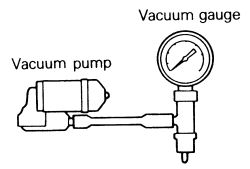What is vacuum distillation?

Vacuum distillation is the distillation of a liquid under reduced pressure. The atmospheric pressure in the distillation tank is reduced making it possible to boil the liquid at a lower temperature. Liquids boil at lower temperatures under reduced pressure (the inverse is that a liquid boils at a higher temperature under pressure, which is why they use a pressure cap on an automobile radiator to increase the boiling point of the engine coolant to prevent boil-over).
Why do you use vacuum distillation?
Vacuum distillation is used to safely recover higher boiling point solvents. We limit the maximum temperature of the distillation unit’s heater. There is a temperature at which a flammable or combustible material can ignite by temperature only, this is called the autoignition temperature (this is discussed later).
Some solvents boil at temperatures that exceed the temperature that the distillation heater can reach (392ºFahrenheit). Vacuum distillation lowers the boiling point to allow recovery within the heaters maximum setting.
When do you use vacuum distillation?
It is used to safely recover solvents with boiling points over 300ºFahrenheit. Vacuum distillation should not be used on solvents with boiling points below 200º Fahrenheit.
If the maximum heater setting is 392º Fahrenheit, why do I need to use vacuum distillation for solvents with boiling points over 300º Fahrenheit, don’t you mean solvents with boiling points over 392º Fahrenheit?
No! When boiling a liquid, two factors come in to play. One is the requirement to have a “driving force” to force the liquid to boil and vaporize. This “driving force” is in the form of extra temperature to allow the solvent to develop a good rolling boil. The other factor is the role of the non-volatile residue. As you boil off solvent and the remaining mixture in the distillation tank becomes more concentrated in the nonvolatile
material, the vapor pressure drops (Raoult’s Law) and most important, the boiling point goes up! So bottom line is that you need 50 to 100 degrees of extra temperature to do a good job of boiling the waste solvent. Also, the concentrated non-volatile material acts as an insulator towards the end of the process as it becomes more and more concentrated. So, as the percentage of non-volatiles in the contaminated solvent increases, the required heat to completely distill the mixture also increases. Sometimes solvents that have
boiling points of 318ºF (Xylene) may not require a vacuum if they are not highly contaminated but almost definitely would if the solid content was greater than, lets say 10%. Pulling a vacuum on such a mixture will reduce its boiling point and the overall time to process it.
How is the vacuum created?

The vacuum is generated using our JetVac technology. A stainless steel reservoir is primed once with clean solvent. A small stainless steel pump is immersed in the liquid and is attached to an explosion proof electric motor. When the motor is started, clean solvent is drawn into the pump and forced through a metal tube known as an aspirator. The aspirator looks like an open piece of pipe with a small orifice (hole) on one side. As the high velocity fluid is pumped across the face of the orifice, it creates suction (like a venturi on a carburetor). Air is pulled through the venturi from the distillation system and passes through a vent.








